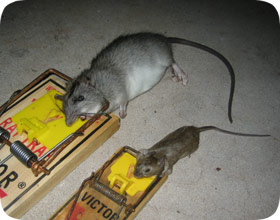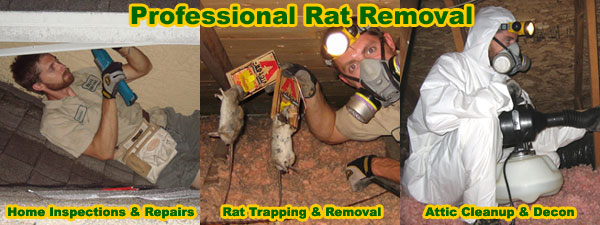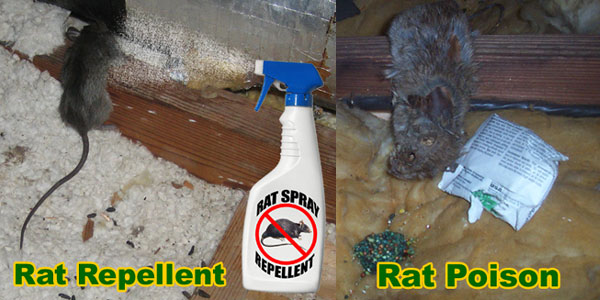- info@wildlife-removal.com
Call us for help in your town
Wildlife Removal Education
Rat Removal and Control
Need rat removal in your hometown? We service over 500 USA locations! Click here to hire us in your town and check prices - updated for year 2021.
 Rats are classified as a pest species due to their habits of living in houses, gnawing, and spreading diseases. The most common complaints include the following:
Rats are classified as a pest species due to their habits of living in houses, gnawing, and spreading diseases. The most common complaints include the following:
- Rats living in the attic
- Rats scratching in the walls
- Rats raiding the pantry
- Gnawing on electrical wires
- Concerns over health risks
Since it's a very common problem, I have here an advice article with photos on how to get rats out of the attic, which is one of the most
common jobs I do on a day-to-day basis. I will now discuss the basic premise of rat removal, in step-by-step instructions. Any time you see one of the blue links, you can click
that for more detailed rat control information.

STEP 1 - Okay, the first and most important thing you have to do is find out how rats are getting into the building. There are holes all over - missing roof vent screens, plumbing stacks, gaps between the roof
and fascia board, gaps in the siding, areas where pipes go into the house, etc. etc. You will never solve a rat problem until you find all of these openings, and seal them shut with steel, which rats are unable to
chew through. Read this article about how are rats getting in for more info.
STEP 2 - Only after you've sealed the openings shut, you should start trapping and removal. I highly recommend snap traps, not live cage traps, certainly not glue boards, and most definitely not poison! Never
poison rats, it doesn't solve the problem and it just creates more problems. PLEASE read my how to trap a rat guide for good tips and methods on proper rat trapping.
STEP 3 - Monitor the situation. Check the traps periodically, remove any dead trapped rats, and reset the traps. Listen for rat evidence, like their scurrying and running noises in the attic, and scratching in
the walls. Look for fresh droppings. Check the repairs you've done, to make sure no new areas have been chewed open. If you've sealed the house correctly, then you shouldn't trap any new rats after just the first three
days.
STEP 4 - Once you're satisfied that there is no more evidence of rats, and you are not trapping any new rats, you should clean the attic or whatever area they were living in, to remove the contamination and
biohazard, and also to eliminate the rat scent, which will attract new rats to try to chew their way into the house in the future.
If you need to hire professional help, you can call us. We service 99% of the USA. You can also read about How much does rat control cost? Get rat extermination prices.

NUISANCE CONCERNS:
Rats and mice may be the most commonly known nuisance mammal species worldwide. They can be important agricultural pests, but the real concern is their tendency to feed on human food stores, often contaminating what they
do not eat. They also chew, and can destroy electrical wires and pretty much anything they get their teeth on. The wire chewing can cause electrical shorts, or worse, fire risks. Sometimes they chew on PVC plumbing and
cause water leaks. Click here for rat damage photos of chewing on
wires and such. Most of the calls that I get regarding rats has to do with the noise people hear the rats making up in the
attic or in the walls. They leave behind a lot of waste in the form of urine and feces. Click here for photos of rat poop. They're also known carriers of zoonotic diseases of
course.
RAT BIOLOGY:
Roof Rat (Rattus rattus) Is also known as the Black Rat, Ship Rat, or House Rat. It is very common in the more southern states. Adults average 7-8 inches long with an additional 8 inch tail, and weigh between
6-10 ounces. Males are usually larger. They breed year-round, and have up to five litters per year. A female can become pregnant within 48 hours after giving birth. The young grow quickly, and are sexually mature within
three months. It's rare for rats to live more than one year in the wild, though lab/pet rats can live up the three years. They love to live in attics, hence their name.
Norway Rat (Rattus norvegicus) Is also known as the Brown Rat. These rats are larger than Roof Rats, with a more robust body, slightly longer, but a bit shorter tail. They can weigh up to a pound. They are
more common in northern parts of the country. They are more likely to live at ground level, like below a house, or in the basement, but can inhabit any part of a building.
Both types of rats have excellent hearing and sense of smell, but poor eyesight. They often travel via urine or pheromone pathways. They have excellent speed and balance, and can easily climb most surfaces.
They seek out shelter in safe places, and they also seek out warmth and food, and that's why you'll often find rats in buildings.
MICE AND RAT BEHAVIOR: Though than can live in a variety of natural habitats. Roof rats tend to live up in trees, whereas Norway Rats and mice live at ground level or even in underground burrows. However, these
rodents are known for their association with and dependence on humans. They very frequently live in people's homes or other buildings, such as the attic or rats in the basement, especially if these buildings contain or are near food sources. These rodents
establish a relatively small home range, and don't travel very far. They are nocturnal, and wait until night, when everything is safe and quiet, before venturing out in search of food. They eat a variety of foods, but
often prefer grains. They have rodent teeth that continually grow, and they gnaw on objects in order to wear down the teeth. They can be somewhat territorial, though high population densities can mess up territories.
MICE AND RAT DISEASES:
Everyone knows about the now-rare Bubonic plague, or “Black Death” of the Middle Ages, but there are over 30 different types of disease are associated with rats and their droppings. They include Rat-bite fever
(Streptobacillus moniliformis bacteria), which is transferred from the bite of a rat, the Rickettsia virus, which is similar to chicken pox, Hantavirus, which can cause febrile illness in humans and sometimes
kidney, blood, or respiratory ailments, Eosinophilic Meningitis - an infection of the brain, and caused by rat lung worm. The droppings of rats can cause Leptospirosis or Salmonellosis, and rats and mice also
bring parasites into the home.
HOW DO I GET RID OF MICE AND RATS?
I've dedicated a full article to the subject here, on my How to get rid of rats page, but first of all, do not use poison. Poison will never kill all the rodents, and it's only a temporary attempt at a solution - once you kill a few rodents, new ones will just come and take their place. They reproduce very
quickly, and space or food supplies will dictate populations. Plus, the use of poisons will frequently mean dead and smelly rats in the attic or walls. Click here for reasons why you should not hire a
pest control company for rats. The only surefire way to get rid of a rat or mouse problem is to
find out how they are getting into the building - seal off all of those area, up to 1/4 inch wide, with steel, and this will keep them out. Once you prevent ingress/egress, you can trap and remove all the rats for
a permanent solution. It's much easier said than done. Even experienced pros can miss the dozens of tiny spots that a home might have that will allow rat or mouse entry. Then trapping is another art unto itself.
You can't just slap a couple of traps near the attic hatch, they must be placed, dozens of them, strategically on the rat or mouse runways in the attic, on pipes, etc.
SHOULD I POISON THE RATS?
Again, no! Not unless you want the stench of dead rats in your house, and you want to not actually solve the problem. Read my page about how to kill a rat for the best
techniques for rat killing and removal without poisons.
CAN I DO ANY RAT PREVENTION?
Yes! You can keep your property as clean as possible, with as little debris as possible. Don't leave out garbage. Don't leave out pet food. Pick up fallen fruit from fruit trees. Keep compost contained. A cat might even help outside, although
a cat will absolutely not help inside (you may be reading this page wondering why your pet cat hasn't caught the rats in your attic or walls). But most importantly, when it comes to rats inside homes and buildings, as
I've stated above, the best form of rat prevention is to seal shut the holes the rats use to enter the structure. Read more about it on my rat prevention page.
CAN'T I JUST USE A REPELLENT?
The most common form of "repellent" used is poison, which does not work well, but many other deterrent devices have been developed and marketed. High-frequency sound machines, various odors, etc. Unfortunately, none
of these gimmicks work well. I've often trapped rats and mice right next to operating ultrasonic sound machines, just to prove how useless they are. You can read more about it here, on my
rat repellent page. The only way to take care of a rat or mouse problem, folks, is to
stop the rodents from getting into the house in the first place! Then you can trap and remove them.

Click here for a nationwide list of 100's of professional mice & rat trappers serving all 50 states.
Phoenix Mouse and Rat Control -
Los Angeles Mouse and Rat Control -
San Diego Mouse and Rat Control -
San Jose Mouse and Rat Control -
Denver Mouse and Rat Control -
Orlando Mouse and Rat Control -
Miami Mouse and Rat Control -
Jacksonville Mouse and Rat Control -
Atlanta Mouse and Rat Control -
Chicago Mouse and Rat Control -
Baltimore Mouse and Rat Control -
Charlotte Mouse and Rat Control -
Portland Mouse and Rat Control -
Philadelphia Mouse and Rat Control -
Houston Mouse and Rat Control -
Seattle Mouse and Rat Control
Rat Email From Reader: Hi David,
I love your site and especially the blog with all the detail show how well you do your job. Unfortunately, I am from Canada and cannot hire you to take care of my rat problem.
Here is my situation, I bought a house and there are roddent droppings in the attic. So I was looking for someone to take care of the rats and cleanup. However, not many will do the cleanup or changing too much. So I decided to tackle the task myself.
I am trying to trap the rat before the cleanup. At first I setup only 2 trap to see if there is any activity. I trapped one rat on the 2nd or 3rd day then nothing. I even setup a few more traps but got nothing. So my question are,
1) How much traps do I need to setup? How close or far away should I place the trap? (The total attic area is about 800sqf but not in a
continuous space.
2) Do you think I only have one rat in the attic and is it normal?
3) Are rat smart enough to avoid trap?
4) If I did not trap all the rats before I cleanup, what do you think the worst things could happen?
5) Is there any method to find out if there is still any rat living in the attic?
Hope you can give me some insight so I can take care of the problem. Thanks, Johnny
My Response: 1 - I usually set about a dozen traps. 2 - Sometimes there is only one rat, but usually there are several. I've caught up to 18 rats in a single attic. 3 - Rats are smart, but they follow
consistent behavior. Set the traps the proper way, on the rat runways, and you will catch them without a problem. 4 - The worst that would happen is that your attic would become contaminated with rat feces again.
5 - The best way to tell if the problem is solved is to check your traps and make sure no new ones are being caught, and to listen for evidence of rats - the running and scratching in the ceiling or walls. If
you've sealed your house properly, then you won't have to worry about any more rat problems.
Other rat removal topics to read about:
Biology of Black Rats
About Rats - Facts and Information
What Animals Do Rats Kill?
How To Get A Rat Out Of Your Bedroom
What If You Are Bitten By a Rat
Do Rats Bite Sleeping Babies?
Do Rats Have Bones? How Can They Fit In Such Small Holes?
Do Rats Dig Holes?
Do Rats Eat Cheese? Do They Like It?
How To Get Rats Out Of The Garage
An Analysis of Inhumane Glue Traps for Rats
Do Rats Hibernate?
How to Keep Rats Away from Compost Heaps
What Kind of Bait Will Trap Rats?
Rats in a Dumpster — How to Get Them Out
21 Simple Tips to Keep Rats Out of Your Garden
Is Professional Rat Control Really Worth It?
The One Rat Removal Method that DOESN’T Require Poison, Trapping or Dead Rats


















